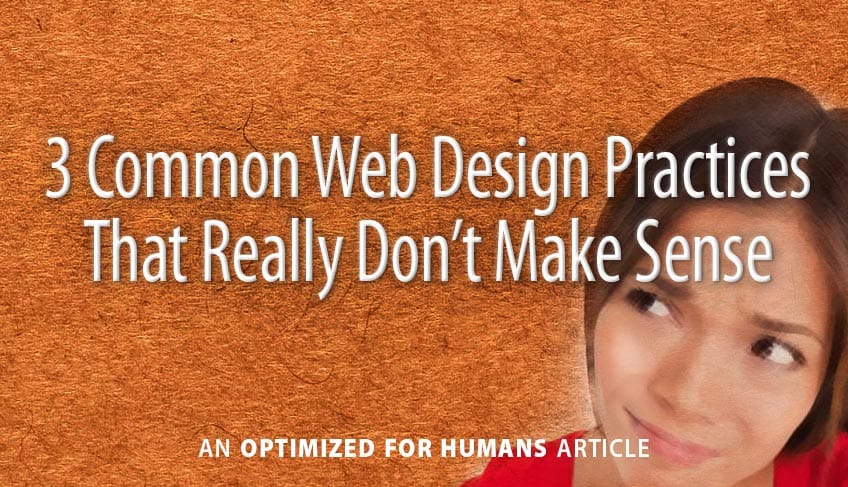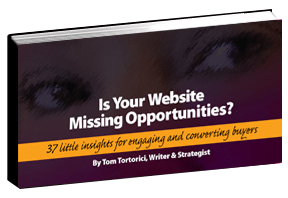
B Y T O M T O R T O R I C I
Humans have a tendency to do things ‘the old way’ simply because it feels comfortable and familiar. In business website design, though, that dynamic may be making the process unnecessarily difficult for web clients, web designers, and website visitors.
So let’s take a step back, revisit a few common approaches, and explore whether there’s a better way. Sound okay?
1. Presenting in bits and pieces
Often, a designer or agency will have me to work directly with the client in creating web copy/content, which is fine.
When the first draft is complete, I submit it to that client in a Word or Google doc for review and revisions. In the meantime, the web designer is showing them design mock-ups for review and revisions.
It’s occurred to me that this is a terrible experience for that poor client. There’s no way they can visualize what the final website will look like with all the text and design elements in place. They’re responsible for approving something really important without seeing how the final site will appear to other people.
Here’s a better way: Build out the proposed new site with the proposed new content in place. When that completed package is presented whole-hog to the client, they’ll have the same strong first impressions and website experience that their customers soon will.
If there are design changes, the designer can make them just as they would with a mock-up. If there are text changes, it’s as easy for the writer to make them on the website back-end as in a text document.
Who benefits: Clients, of course. They’re more likely to be ‘wowed’ when presented with the final product.
2. Taking an extra, unnecessary step
Remember those design mock-ups we just mentioned? Unless it’s a particularly large and complex site, think about whether they’re really necessary.
Here’s a better way: Once the designer has an idea of their design direction, plus a simple outline of pages & elements, they can just start building the site rather than the mock-ups. In other words, use your pagebuilder tool as your mock-up tool.
With the huge amount of flexibility offered by today’s pagebuilders, making changes later is just as easy as making changes to a mock-up.
So let’s compare. The old way: After the client reviews the design mock-ups and text doc, and revisions are made, it’s time to … start building the final site from scratch. The new way: after revisions are made to the comprehensive dev site, it’s time to … send an invoice, because you’re already done!
Who benefits: designers, of course. Less project time means a lower estimate, and a better chance of getting the job.
3. Emphasizing the wrong page
Traditionally, website Home pages are the ‘main’ page of a business website; a lot of time and thought is typically put into them. The interior or sub-pages? Typically, not so much, often with running text simply flowed into a plain blog-style page.
The issue though, is that many (if not most) companies serve more than one market. Smart marketers know to talk to each of those markets separately, focusing on what’s most important to each. In fact, instead of talking about company capabilities in a generic sense, it’s far more effective to describe those capabilities in terms of each specific market’s needs.
Here’s a better way: Consider making your main Home page simply a portal, dominated by 3-across boxes that target the 3 chief markets or industries that the company serves. Other than a generic company message in the banner, there shouldn’t be much of anything else to distract folks from clicking on the appropriate box. That click takes them to a dedicated full Home page that speaks just to their industry.
That may seem like more work for the designer, compared to simply flowing text into long-form text pages. But with your pagebuilder, you just need to build out one of those industry-specific Home pages; then just dupe it for the others, and replace the written content and images.
Who benefits: Visitors, of course. The info they see is relevant and focused on their specific needs.
Make sure it makes sense.
In addition to these 3 ideas for improving web-design efficiency and effectiveness, take that step back and see if you can come up with some of your own. You may soon be scratching your head, wondering why you did things the old way for so long.
Designers: Want to work with a writer who know how to make your life easier? Let’s talk about it.
Share It:
 About the Author: Tom Tortorici is an Atlanta copywriter and web content writer who helps companies make a genuine connection with their audience. His classes and conference presentations have focused on how writing, strategy and design can work together to grab attention and interest even among readers with short attention spans. In addition to working directly with businesses, Tom regularly partners with web designers and marketing agencies.
About the Author: Tom Tortorici is an Atlanta copywriter and web content writer who helps companies make a genuine connection with their audience. His classes and conference presentations have focused on how writing, strategy and design can work together to grab attention and interest even among readers with short attention spans. In addition to working directly with businesses, Tom regularly partners with web designers and marketing agencies.
All Posts/Subscribe >
Info for Businesses >
Info for Designers/Agencies >
Tom Tortorici Inc. | Tom@TomTortorici.com | 770-934-7861 | 3101 Rockaway Rd | Atlanta GA 30341

